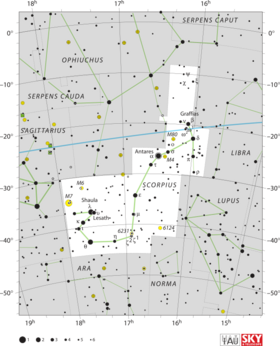Astronomy:Q Scorpii
| Observation data Epoch J2000.0 Equinox (celestial coordinates) | |
|---|---|
| Constellation | Scorpius |
| Right ascension | 17h 36m 32.85514s[1] |
| Declination | −38° 38′ 06.8918″[1] |
| Apparent magnitude (V) | 4.27±0.01[2] |
| Characteristics | |
| Evolutionary stage | horizontal branch[3] |
| Spectral type | K0 IIIb[4] |
| U−B color index | +0.90[5] |
| B−V color index | +1.08[5] |
| Astrometry | |
| Radial velocity (Rv) | −49±3[6] km/s |
| Proper motion (μ) | RA: −16.762[1] mas/yr Dec.: −218.275[1] mas/yr |
| Parallax (π) | 20.6922 ± 0.2161[1] mas |
| Distance | 158 ± 2 ly (48.3 ± 0.5 pc) |
| Absolute magnitude (MV) | +0.67[7] |
| Details[8] | |
| Mass | 1.10±0.07 M☉ |
| Radius | 12.39±0.47 R☉ |
| Luminosity | 62.2±4.2 L☉ |
| Surface gravity (log g) | 2.41±0.11 cgs |
| Temperature | 4,605±40 K |
| Metallicity [Fe/H] | −0.28±0.02 dex |
| Rotational velocity (v sin i) | <1[9] km/s |
| Other designations | |
| Database references | |
| SIMBAD | data |
Q Scorpii, also designated as HD 159433, is an astrometric binary[11] (100% chance)[12] located in the southern zodiac constellation Scorpius. It has an apparent magnitude of 4.27,[2] making it readily visible to the naked eye under ideal conditions. It lies in the tail of Scorpius, between the stars λ Scorpii and μ Scorpii and is located 7′ away from the faint globular cluster Tonantzintla 2. Based on parallax measurements from Gaia DR3, the system is estimated to be 158 light years distant,[1] but is approaching the Solar System with a heliocentric radial velocity of −49 km/s.[6]
The visible component is a red giant with a stellar classification of K0 IIIb.[4] The IIIb luminosity class indicates that it is a lower luminosity giant star. Q Scorpii is a red clump star located on the cool end of the horizontal branch,[3] fusing helium at its core. It has 110% the mass of the Sun but has expanded to 12.4 times its girth.[8] It radiates 62 times the luminosity of the Sun from its photosphere at an effective temperature of 4,605 K,[8] giving it an orange hue. Q Scorpii has an iron abundance half of the Sun's, making it metal deficient.[8] Like most giant stars, it spins slowly, having a projected rotational velocity lower than 1 km/s.[9]
References
- ↑ 1.0 1.1 1.2 1.3 1.4 Vallenari, A. et al. (2022). "Gaia Data Release 3. Summary of the content and survey properties". Astronomy & Astrophysics. doi:10.1051/0004-6361/202243940 Gaia DR3 record for this source at VizieR.
- ↑ 2.0 2.1 Høg, E.; Fabricius, C.; Makarov, V. V.; Urban, S.; Corbin, T.; Wycoff, G.; Bastian, U.; Schwekendiek, P. et al. (March 2000). "The Tycho-2 catalogue of the 2.5 million brightest stars". Astronomy and Astrophysics 355: L27–L30. ISSN 0004-6361. Bibcode: 2000A&A...355L..27H.
- ↑ 3.0 3.1 Laney, C. D.; Joner, M. D.; Pietrzyński, G. (11 November 2011). "A new Large Magellanic Cloud K-band distance from precision measurements of nearby red clump stars". Monthly Notices of the Royal Astronomical Society 419 (2): 1637–1641. doi:10.1111/j.1365-2966.2011.19826.x. ISSN 0035-8711. Bibcode: 2012MNRAS.419.1637L.
- ↑ 4.0 4.1 Hoffleit, Dorrit; Shapley, Harlow (1937). "Spectroscopic absolute magnitudes of three hundred and seventy southern stars". Annals of Harvard College Observatory 105 (3): 45–68. Bibcode: 1937AnHar.105...45H.
- ↑ 5.0 5.1 Cousins, A. W. J. (1971). "Photometric standard stars". Royal Observatory Annals 7. Bibcode: 1971ROAn....7.....C.
- ↑ 6.0 6.1 Gontcharov, G. A. (November 2006). "Pulkovo Compilation of Radial Velocities for 35 495 Hipparcos stars in a common system". Astronomy Letters 32 (11): 759–771. doi:10.1134/S1063773706110065. ISSN 1063-7737. Bibcode: 2006AstL...32..759G.
- ↑ Anderson, E.; Francis, Ch. (May 2012). "XHIP: An extended hipparcos compilation". Astronomy Letters 38 (5): 331–346. doi:10.1134/S1063773712050015. ISSN 1063-7737. Bibcode: 2012AstL...38..331A.
- ↑ 8.0 8.1 8.2 8.3 Ottoni, G.; Udry, S.; Ségransan, D.; Buldgen, G.; Lovis, C.; Eggenberger, P.; Pezzotti, C.; Adibekyan, V. et al. (January 2022). "CORALIE radial-velocity search for companions around evolved stars (CASCADES): I. Sample definition and first results: Three new planets orbiting giant stars". Astronomy & Astrophysics 657: A87. doi:10.1051/0004-6361/202040078. ISSN 0004-6361. Bibcode: 2022A&A...657A..87O.
- ↑ 9.0 9.1 De Medeiros, J. R.; Alves, S.; Udry, S.; Andersen, J.; Nordström, B.; Mayor, M. (January 2014). "A catalog of rotational and radial velocities for evolved stars". Astronomy & Astrophysics 561: A126. doi:10.1051/0004-6361/201220762. ISSN 0004-6361. Bibcode: 2014A&A...561A.126D.
- ↑ "Q Scorpii". SIMBAD. Centre de données astronomiques de Strasbourg. http://simbad.u-strasbg.fr/simbad/sim-basic?Ident=Q+Scorpii.
- ↑ Eggleton, P. P.; Tokovinin, A. A. (11 September 2008). "A catalogue of multiplicity among bright stellar systems". Monthly Notices of the Royal Astronomical Society 389 (2): 869–879. doi:10.1111/j.1365-2966.2008.13596.x. ISSN 0035-8711. Bibcode: 2008MNRAS.389..869E.
- ↑ Frankowski, A.; Jancart, S.; Jorissen, A. (19 December 2006). "Proper-motion binaries in the Hipparcos catalogue". Astronomy & Astrophysics 464 (1): 377–392. doi:10.1051/0004-6361:20065526. ISSN 0004-6361. Bibcode: 2007A&A...464..377F.
<ref> tag with name "Gould1879" defined in <references> is not used in prior text.
 |


